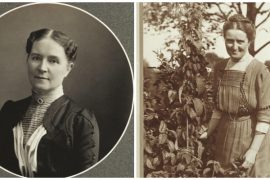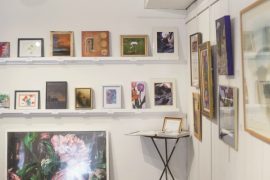By Rachel Wisinski
“Presenting history is storytelling, and i think there are a lot of history attractions like Old World that can learn from how Disney tells stories,” says Director Dan Freas.
Roaming the 600 acres at the interactive history museum transports visitors into seven different cultures, including an 1880s village, and farms of the Yankees, Finns, Danes, Norwegians, Poles and Germans.
It’s the stories of these ethnic groups the museum strives to share.
Above all, Freas and his crew give extra attention to the customer experience and service they provide. He compares methods used at Old World Wisconsin to how Pixar creates its films, such as “Monsters, Inc.” or “The Incredibles.”
While the movies tell a story in terms kids can understand, they also throw in humor for adults, which breezes over most kids’ heads. “Unlike a lot of kids’ movies, it’s something the parents can take the kids to and kind of enjoy instead of simply enduring,” says Freas.
In a similar way, Old World Wisconsin creates opportunities to entertain guests of all ages, including how staff interact with them. Freas says lead interpreters, who are stationed in each building, with the exception of two, are meant to engage customers to see what they’re looking for out of the experience.
Disney considers its workers cast members, likening them to part of a production, and Freas says no matter what role they play in the customer experience, each member of the team should be able to answer questions, help improve guest involvement and show proper courtesy. He tries to instill that attitude into his workers, as well as the expansive volunteer base on which the museum relies. It alone employs the help of about 40 gardeners, all at no cost.
A CHANGING TIDE
Freas brought his goals to Old World Wisconsin when he arrived in winter 2012. He previously served as vice president of experiences at a similar facility, Connor Prairie Interactive History Park in Fishers, Indiana.
Knowing Old World Wisconsin’s reputation and looking for a new challenge, Freas jumped at the opportunity. He set to work fulfilling the facility’s needs — especially in the ways of becoming more family-friendly and providing more hands-on interactions for guests.
Along with a new master plan, Freas and other Old World officials devised new ways to improve the museum. In the 3 1/2 years since he moved north, Freas has overseen a number of changes, including the addition of a new building and attraction, Catch Wheel Fever, which opened in June 2014. It’s here visitors can learn about the coming of age of the bicycle. They can try their hand at riding a tricycle from the 1890s, a model which includes a raised seat flanked by two oversized wheels, and a smaller wheel at the rear.
Freas says the attraction was added in part because a specialized group came to assess the facility, and it noted the museum’s weaknesses included a lack of some type of a ride for visitors.
In fixing this, Old World Wisconsin created an all-encompassing attraction — not only can guests participate in a ride around a small dirt track outside a mid-sized barn, but they can become immersed in the period through bicycle music (recorded by local artists), try on vintage clothing and have a look around the detailed workshop.
Working at Old World since 2011, Ryan Schwartz now serves as the lead interpreter — meant to facilitate the exhibits’ experiences, Freas says — for Catch Wheel Fever.
“It really adds that extra dimension,” says Schwartz. “There are different types of learners. There are aural learners, visual learners, so this brings something for everyone.”
He says the ride has been popular since its inception. Sometimes families will return at the end of the day after making their rounds through other exhibits. And by adding the attraction, he says it also has provided something fresh for those who have visited Old World on multiple occasions.
AROUND THE WORLD
Freas and his staff have tried to incorporate innovative experiences into other parts of the museum as well.
Guests who stop at the German farms can learn firsthand the challenges that come with cooking on a wood stove and completing daily chores. The experience as it was in the past left guests wishing they could participate in more hands-on activities at other locations, so this year Old World staff revamped the experience to bring new tasks to each of the three farms — one focused on household chores, one on textile production and one on food preservation and baking.
The exhibit is now renamed “Life on the Farms” and guests follow in the footsteps of farm family members to feed animals, split wood, collect eggs, mow the lawn and more.
To further guest participation, visitors to the 1880s village have the option of using a $5 historic coin, bought at the time of admission, to buy one of seven items in the general store, including a tin cup or a slate used in the schoolhouse demonstrations.
“Really, what we want them to do is be inspired by the stories that we’re telling, and make them think about what people experienced in the past, but also how it connects today,” says Freas.
The historic buildings featured throughout the museum were taken apart and relocated from various sites across the nation when Old World Wisconsin opened in 1976. From a one-room schoolhouse to an old Catholic church and various historic homes, visitors are taken back to the 19th century through all aspects of life.
Also to maintain authenticity, Freas and the staff have worked to restore prairie grasses. The grounds house historic breeds of livestock, including an Ossabaw Island hog, a cow and calf, sheep and two oxen. The gardens also raise a variety of 19th century plants, herbs and crops.
All of these details serve as a means for Old World Wisconsin to allow its guests to think about their own family history, says Freas. They can determine what brought their family to Wisconsin, or for the museum’s out of state visitors, what struggles all immigrants of the time endured.
“I can’t remember the quote that’s on the Statue of Liberty, but it’s the idea of America being the place where those can come to start a new life. That’s still very relevant today,” Freas says.
What sets Old World Wisconsin apart from other historical museums is not only its emphasis on people’s heritages and different ethnic backgrounds, but it’s the dedication to these authentic experiences, Freas says.
Eagle resident Sioux Collom, 17, began working at Old World Wisconsin in June. Dressed head to toe in traditional 19th century dress, bonnet and shoes, she stands at the front entrance greeting guests as they arrive.
Collom had previously visited Old World Wisconsin many times. Her interest in history and theater made her believe she would be right for one of the roles workers and volunteers take on at the museum. She’s gotten more culture from her experience, however, than she expected.
“I think the best part is people coming from out of the country,” Collom says. “I love the accents and the diverse amount of people that come here.”
In 2014, Old World Wisconsin welcomed about 74,000 guests through its gates. The museum is open from June through October, so there’s plenty of time this year to enjoy this one-of-a-kind family experience. Throughout the off season, Old World Wisconsin also has worked to offer various workshops, so visitors can become better acquainted with a specific exhibit at the museum. While one workshop teaches customers how to cook food using period recipes from the German settlers, another shows guests how to use basic skills in the blacksmith shop.
AUTUMN AT OLD WORLD
Fall is the perfect season to visit Old World Wisconsin. For a complete list of upcoming events, visit oldworldwisconsin.wisconsinhistory.org.





